
- Home
- Travel Packages
- Top Destination
-
Travel Attraction
By Category
Top Attraction

- Travel Agents
- Car Rentals
- Hotels
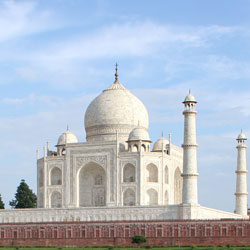
About The Taj Mahal The Taj Mahal is one of the most famous and iconic landmarks in India, located in the city of Agra, Uttar Pradesh. It is a UNESCO World Heritage Site and is considered one of the seven wonders of the world. Built by the Mughal Emperor Shah Jahan in memory of his wife Mumtaz Mahal, the Taj Mahal is a symbol of eternal love and architectural beauty. Timings Of Taj Mahal The Taj Mahal is open to visitors from sunrise to sunset, every day of the week except for Fridays. The monument is closed on Fridays for general viewing but is open for those who want to attend prayers at the mosque located within the premises. Entry Fee The entry fee for the Taj Mahal varies for Indian and foreign tourists. Indian tourists have to pay INR 50, while foreign tourists have to pay INR 1300. Children below the age of 15 can enter for free. Required Time And Restricted Items It is recommended to spend at least 2-3 hours exploring the Taj Mahal to truly appreciate its beauty. Visitors are not allowed to bring food, weapons, tobacco, or alcohol inside the monument. Drone photography is also strictly prohibited. Architecture Of Taj Mahal The Taj Mahal is a masterpiece of Mughal architecture, blending elements from Persian, Turkish, Indian, and Islamic architectural styles. The white marble mausoleum is adorned with intricate carvings, calligraphy, and semi-precious stones, making it a symbol of exquisite craftsmanship. Best Time To Visit The best time to visit the Taj Mahal is during the cooler months of October to March, when the weather is pleasant and comfortable for sightseeing. The early mornings and late evenings offer a magical view of the monument as the sunlight plays on its marble surface. How To Reach The Taj Mahal is easily accessible by road, rail, and air. The nearest airport is in Agra, the Agra Airport, which is well-connected to major cities in India. Agra also has a railway station with regular trains from Delhi, Jaipur, and other cities. History Of Taj Mahal The Taj Mahal was built between 1631 and 1653 by Emperor Shah Jahan in memory of his beloved wife Mumtaz Mahal, who died during childbirth. The construction of the mausoleum took over 20,000 workers and artisans to complete, and it is said to have cost an astronomical sum for that time. Inside Taj Mahal Inside the Taj Mahal, visitors can find the cenotaphs of Shah Jahan and Mumtaz Mahal, surrounded by intricate marble screens and inlaid floral designs. The main chamber houses the false tombs of the emperor and his wife, while the actual graves are located in a chamber below, closed to the public. Traveling Tips It is advisable to wear comfortable clothing and footwear while visiting the Taj Mahal, as you will need to walk around the complex. It is also recommended to carry a hat, sunglasses, and sunscreen to protect yourself from the sun. Hiring a guide can enhance your experience by providing insights into the history and architecture of the monument. Hotels Near Taj Mahal There are several hotels near the Taj Mahal that offer a range of accommodation options for visitors. Some of the popular hotels include the Oberoi Amarvilas, Tajview - IHCL SeleQtions, ITC Mughal, and Trident Agra. Nearby Tourist Spots Of Taj Mahal While visiting the Taj Mahal, tourists can also explore other attractions in Agra such as Agra Fort, Fatehpur Sikri, Mehtab Bagh, and the Tomb of Itimad-ud-Daulah. These sites offer a glimpse into the rich history and culture of the Mughal era.
Explore More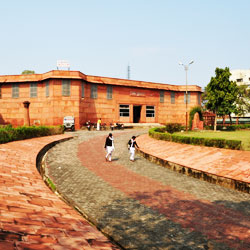
Cunnigham, Growse, Fuhrer and others unearthed the rich treasure of antiquarian values, which form the nucleus for the present museum located at Dampier Park, Mathura. It houses rich collections of fine sculpture, terracotta, bronze objects of the Maurya, Sunga, Kushan and Gupta periods. It also houses the famous standing Buddha from the 5th century AD.
Explore More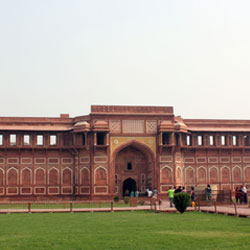
About The Agra Fort The Agra Fort, also known as the Red Fort of Agra, is a UNESCO World Heritage Site located in Agra, Uttar Pradesh, India. It is a historical fort that served as the main residence of the emperors of the Mughal Dynasty until 1638. The fort's imposing walls, intricate architecture, and rich history make it a must-visit attraction for tourists visiting Agra. Timings Of Agra Fort The Agra Fort is open from sunrise to sunset every day of the week, including public holidays. The timings may vary during certain events or festivals, so it is advisable to check the official website or local authorities for updated information before planning your visit. Entry Fee The entry fee for visiting the Agra Fort varies for Indian and foreign tourists. Indian nationals are charged a nominal fee, while foreign tourists have to pay a higher amount. Additionally, there may be separate charges for using a camera or video recording equipment inside the fort premises. Required Time And Restricted Items Visitors typically spend around 2-3 hours exploring the Agra Fort and its various sections. However, the time duration may vary depending on individual interests and pace. It is advisable to avoid carrying large bags, food items, or any prohibited items such as weapons, inflammable objects, or alcohol inside the fort premises. Architecture Of Agra Fort The Agra Fort showcases a unique blend of Islamic, Persian, and Indian architectural styles. The fort's massive defensive walls are made of red sandstone, giving it the name "Red Fort." Inside, visitors can admire the intricate carvings, marble structures, stunning domes, and beautiful gardens that reflect the grandeur of the Mughal era. Best Time To Visit The best time to visit the Agra Fort is during the winter months of October to March when the weather is pleasant and ideal for exploring the historical site. It is recommended to avoid visiting during the scorching summer months of April to June, as the temperatures can be extremely high. How To Reach The Agra Fort is easily accessible by road, rail, and air. The nearest airport is the Agra Airport, which is well-connected to major cities in India. Agra Railway Station is located near the fort and has regular trains to various parts of the country. Visitors can also hire taxis, auto-rickshaws, or use public transportation to reach the fort. History Of Agra Fort The Agra Fort was originally built as a military structure by the Mughal Emperor Akbar in 1565. Over the years, it underwent several expansions and renovations by subsequent emperors such as Jahangir, Shah Jahan, and Aurangzeb. The fort played a significant role in the Mughal Empire's administration and was the site of many important events and battles. Inside Agra Fort Inside the Agra Fort, visitors can explore various sections such as the Diwan-i-Am (Hall of Public Audience), Diwan-i-Khas (Hall of Private Audience), Jahangir Mahal, Khas Mahal, Sheesh Mahal, and Musamman Burj. Each area has its unique features, including intricate carvings, beautiful paintings, and stunning views of the Taj Mahal. Traveling Tips To make the most of your visit to the Agra Fort, it is recommended to hire a guide who can provide detailed information about the history and significance of each section. Wear comfortable footwear as you will be walking on uneven surfaces and stairs. Carry sufficient water and sunscreen to stay hydrated and protected from the sun. Hotels Near Agra Fort There are several hotels and accommodations near the Agra Fort that cater to different budgets and preferences. Some popular options include the ITC Mughal, The Oberoi Amarvilas, Trident Agra, Jaypee Palace Hotel, and Hotel Clarks Shiraz. These hotels offer comfortable stays, delicious cuisine, and easy access to the fort and other tourist attractions. Nearby Tourist Spots Of Agra Fort While visiting the Agra Fort, tourists can also explore other nearby attractions such as the iconic Taj Mahal, Mehtab Bagh, Jama Masjid, Kinari Bazaar, and Akbar's Tomb. These sites offer a glimpse into Agra's rich history, culture, and architectural heritage, making it a memorable travel experience for visitors.
Explore More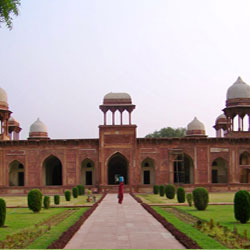
About The Mariam Tomb The Mariam Tomb, also known as the Tomb of Mariam Zamani, is a beautiful Mughal tomb located in Agra, India. It is a significant historical site as it is the final resting place of Mariam-uz-Zamani, who was the wife of the Mughal Emperor Akbar. The tomb is a fine example of Mughal architecture and is a must-visit for history and architecture enthusiasts. Timings Of Mariam Tomb The Mariam Tomb is open to visitors every day of the week from 6:00 AM to 6:00 PM. It is recommended to visit early in the morning or late in the evening to avoid the crowds and the heat. Entry Fee The entry fee to visit the Mariam Tomb is INR 20 for Indian nationals and INR 250 for foreign tourists. There is an additional fee for photography and videography. Required Time And Restricted Items Visitors typically spend about 1-2 hours exploring the Mariam Tomb and its surroundings. Some of the restricted items inside the tomb complex include weapons, large bags, and outside food. Architecture Of Mariam Tomb The Mariam Tomb is a stunning example of Mughal architecture, with intricate carvings, beautiful arches, and stunning domes. The tomb is made of red sandstone and features Persian and Mughal design elements. The intricate details and symmetry of the structure make it a masterpiece of architectural craftsmanship. Best Time To Visit The best time to visit the Mariam Tomb is during the winter months of October to March when the weather is pleasant and ideal for exploring outdoor attractions. How To Reach The Mariam Tomb is located in the Sikandra area of Agra and is easily accessible by road. Visitors can take a taxi, auto-rickshaw, or a local bus to reach the tomb. The nearest railway station is Agra Cantonment, which is about 10 km away. History Of Mariam Tomb The Mariam Tomb was built in the 16th century by Emperor Akbar in memory of his beloved wife, Mariam-uz-Zamani. The tomb is a symbol of their eternal love and is considered a sacred place by many. Inside Mariam Tomb Inside the Mariam Tomb, visitors can see the cenotaph of Mariam-uz-Zamani, which is beautifully decorated with intricate carvings and inscriptions. The interior of the tomb is peaceful and serene, making it a perfect place for reflection and meditation. Traveling Tips - Wear comfortable footwear as you will be walking around the tomb complex. - Carry a hat, sunglasses, and sunscreen to protect yourself from the sun. - Respect the sanctity of the tomb and maintain silence inside. - Hire a local guide to learn more about the history and significance of the Mariam Tomb. Hotels Near Mariam Tomb - The Oberoi Amarvilas - Trident, Agra - Hotel Clarks Shiraz - ITC Mughal, a Luxury Collection Hotel Nearby Tourist Spots Of Mariam Tomb 1. Akbar's Tomb: Visit the majestic tomb of Emperor Akbar, located nearby. 2. Fatehpur Sikri: Explore the UNESCO World Heritage Site of Fatehpur Sikri, known for its splendid Mughal architecture. 3. Taj Mahal: Admire the iconic Taj Mahal, a short drive away from the Mariam Tomb. 4. Agra Fort: Discover the historical Agra Fort, a UNESCO World Heritage Site with a rich Mughal history.
Explore More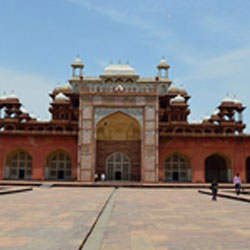
Introduction to Akbar’s Mausoleum Akbar’s Mausoleum was constructed in 1605 and is situated at a region named Sikandra, which is around 10 km away from the Agra city. The mausoleum has a blending of the Muslim-Hindu styles of architecture. The building was constructed with a combination of white marbles and red sandstone. Besides being an architectural innovation, a blending of ancient architectural styles based on red sandstone and trendy white marbles, ornaments, and fine carvings are used in its building. The construction of Mausoleum was started by Akbar, but he couldn’t complete it. Thus, it was on his son Jahangir to see the completion of the Mausoleum. Akbar’s Mausoleum comprises of two buildings. One is the Mausoleum, while the other is a giant gateway, known as Buland Darwaza, connected with each other through a wide corridor. The place is very calm and silent, with stunning, colorful, and grand interiors that include both the well-preserved and the badly damaged parts of the Mausoleum. There is a color shade that resembles the Kalamkari prints, and there’s another which looks like the Thewa jewelry designs. There resides a variety of designs and richness all around. If you are like to witness beautiful architecture and heart throbbing artistic approach, Akbar’s Mausoleum is the perfect place to visit.
Explore More
About The Jahangir Palace The Jahangir Palace, located in Agra, India, is a magnificent palace that was built by Emperor Akbar for his son Jahangir. It is situated within the Agra Fort complex and is a stunning example of Mughal architecture. Timings Of Jahangir Palace The Jahangir Palace is open to visitors from sunrise to sunset every day of the week. Entry Fee The entry fee for visiting the Jahangir Palace is included in the ticket price for the Agra Fort complex. For Indian citizens, the ticket price is Rs. 40, and for foreign tourists, it is Rs. 600. Required Time And Restricted Items Visitors typically spend around 1-2 hours exploring the Jahangir Palace. Restricted items include weapons, alcohol, and any items that can be harmful to the historical structure. Architecture Of Jahangir Palace The Jahangir Palace is known for its elegant design and intricate carvings. It features a blend of Persian and Indian architectural styles, with beautiful jali work, ornate arches, and detailed motifs adorning the walls and ceilings. Best Time To Visit The best time to visit the Jahangir Palace is during the winter months from October to March when the weather is pleasant and ideal for sightseeing. How To Reach The Jahangir Palace is located within the Agra Fort complex, which is easily accessible by road. Visitors can hire a taxi, auto-rickshaw, or take a bus to reach the Agra Fort. The nearest railway station is Agra Cantt, and the nearest airport is Agra Airport. History Of Jahangir Palace The Jahangir Palace was built in the 16th century by Emperor Akbar for his son Jahangir. It served as a residence for the royal family and also housed the administrative offices of the Mughal Empire. Inside Jahangir Palace Inside the Jahangir Palace, visitors can explore the various rooms and chambers that once served as living quarters for the royal family. The palace also offers stunning views of the surrounding gardens and the city of Agra. Traveling Tips Some traveling tips for visiting the Jahangir Palace include wearing comfortable footwear, carrying water and sunscreen, and hiring a guide to learn more about the history and architecture of the palace. Hotels Near Jahangir Palace Some of the hotels near the Jahangir Palace include Hotel Taj Resorts, Hotel Clarks Shiraz, and The Oberoi Amarvilas. These hotels offer luxurious accommodations and excellent hospitality for visitors. Nearby Tourist Spots Of Jahangir Palace Some nearby tourist spots to visit after exploring the Jahangir Palace include the Agra Fort, the Taj Mahal, and the Mehtab Bagh. These attractions offer a glimpse into the rich history and culture of Agra.
Explore More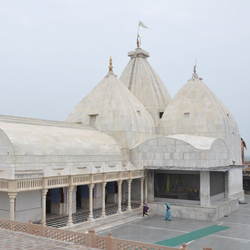
Located at a distance of 30 km away from Mathura (Uttar Pradesh), Nand Bhawan was the house of the foster father of Lord Krishna- Nand Baba. Also known as Chaurasi Khamba Temple, Nand Bhawan is one of the major places of interest in Gokul. This structure is surrounded by lush greenery and the beautiful mountains at the backdrop make this palace more astounding. Visiting Nand Bhawan in Gokul is like experiencing the childhood days of Lord Krishna. This is the place where Shri Krishna spent his childhood time after his actual parents were confined by Kansa (King of Mathura). As per the legends, the name-giving ceremony of Shri Krishna and his brother Balaram had conducted in Nand Bhawan. Architecture Of Nand Bhawan: Nand Bhawan is a vast complex and known for its amazing architecture. The structure is called the Chaurasi Khamba temple as it rests on 84 pillars. The premise of the structure is huge and there are a small number of ascending stairs that are leading to its entrance, which then leads to a huge courtyard. There are wide open spaces around the temple adding charm to its beauty. The walls of the Nand Bhawan are embellished with beautiful paintings and motifs of Shri Krishna portraying playful chapters from his childhood days. One can see splendid carvings etched on the stone pillars of the palace enhancing its beauty. Besides, one can see many fascinating rooms that were allotted to the family members of Nand Maharaj including the room of Nand Baba, Maa Yashoda, Maa Rohini, Lord Krishna, Shri Balaramji, Shri Radhaji, and their friends. The residence also comprises of a dining hall, kitchen, storerooms, restrooms, etc. Interesting Facts And Trivia About Nand Bhawan: People must be wondering, why does the temple comprise exactly 84 pillars? not one more or one less. This is because as per the religious scriptures in Hinduism, the number 84 represents the 84, 00,000 species of life existing in the material world. Thus, it is believed that 84 pillars in the palace comprise of all life forms existing in the world. There is a huge banyan tree in the courtyard of the palace and devotees who visit the palace tie colorful strips or ribbons on its branches, with a strong belief that this will bring them happiness and prosperity in their life. There is a temple of Kali Maa just under this banyan tree. Best Time To Visit Here: Nand Bhawan is situated in Gokul town (Mathura, Uttar Pradesh). Being a famous religious structure, you can visit it any time in the year. During the summer season, the entire Mathura along with Gokul experience extreme heat, with a temperature of around 44 degrees Celsius. The heat can be a major hindrance for many visitors, but if this condition does not bother you much, you can visit Gokul and Nand Bhawan during this period. Winters in Gokul are very favorable for the tourists for sightseeing and exploration in the region as the weather is cool and pleasant. Nearby Attractions: On a trip to Gokul, visitors can also explore some of the other tourist attractions in and around the region other than Nand Bhawan such as Shri Thakur Rani Ghat, Raman Reti, Gokulnath Temple, Brahmand Ghat, etc. How To Reach Here: Situated at a distance of about 10 km from Mathura, Gokul can be easily accessible. The town has good connectivity with major cities in India. • By Air- For air travelers, the nearest airport is in Agra, which is located at a distance of 54 km from Gokul. One can book a taxi or cab to reach Gokul and Nand Bhawan from Agra airport. One can also reach here from Indira Gandhi International Airport in Delhi (186 km) or Jaipur airport (232 km). Visitors can hire a taxi from either airport to reach Gokul and Nand Bhawan. • By Train- For the train passengers, the closest railway station is in Mathura, which is at a distance of about 7 km from the town. One can hire a taxi or cab to reach Gokul and Nand Bhawan from the railway station. Additional Information For Visitors: There is no entry fee required for visiting Nand Bhawan. This temple remains open every day in a week. In summer days, the temple remains open from 5.00 am to 12.00 pm and from 2.00 pm to 9.00 pm. And in winter days, the temple opens from 5.00 am to 12 pm and 2.00 pm to 8.30 pm.
Explore More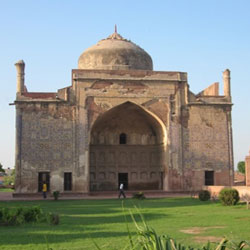
About The Chini-Ka-Rauza The Chini-Ka-Rauza is a historical monument located in Agra, Uttar Pradesh, India. It is a mausoleum of Allama Afzal Khan Mullah, who was a scholar and poet during the Mughal era. The name "Chini-Ka-Rauza" translates to "Tomb of China" in English, and it is known for its intricate Persian glazed tile work. Timings of Chini-Ka-Rauza The Chini-Ka-Rauza is open to visitors from sunrise to sunset on all days of the week. Entry Fee There is no entry fee to visit the Chini-Ka-Rauza. Required Time And Restricted Items It generally takes about 1-2 hours to explore the Chini-Ka-Rauza. Visitors are not allowed to carry any food or beverages inside the monument. Architecture Of Chini-Ka-Rauza The Chini-Ka-Rauza is known for its unique architectural style, which combines Persian and Indian influences. The main tomb is built in the shape of an octagon and is adorned with intricate tile work in shades of blue, green, and yellow. The walls and ceilings are decorated with beautiful calligraphy and geometric patterns. Best Time To Visit The best time to visit the Chini-Ka-Rauza is during the winter months (October to March) when the weather is cooler and more pleasant for sightseeing. How To Reach The Chini-Ka-Rauza is located in Agra, approximately 10 kilometers away from the city center. Visitors can easily reach the monument by taking a taxi or auto-rickshaw from Agra. History Of Chini-Ka-Rauza The Chini-Ka-Rauza was built in 1639 by Afzal Khan, who was a prominent minister in the court of Mughal emperor Shah Jahan. The monument served as a tomb for Afzal Khan and also housed his library of rare books and manuscripts. Inside Chini-Ka-Rauza Inside the Chini-Ka-Rauza, visitors can see the tomb of Afzal Khan surrounded by a beautiful garden. The walls of the monument are adorned with intricate tile work and inscriptions from the Quran. There is also a small mosque on the premises where visitors can offer prayers. Traveling Tips It is advisable to wear comfortable shoes as there is some walking involved while exploring the Chini-Ka-Rauza. Visitors should also carry a hat and sunscreen to protect themselves from the sun, especially during the summer months. Hotels Near Chini-Ka-Rauza Some of the hotels near Chini-Ka-Rauza include: 1. The Oberoi Amarvilas 2. Trident, Agra 3. Hotel Taj Resorts 4. Hotel Taj Villa 5. Hotel Clarks Shiraz Nearby Tourist Spots Of Chini-Ka-Rauza Some of the nearby tourist spots of Chini-Ka-Rauza include: 1. Taj Mahal 2. Agra Fort 3. Itmad-ud-Daulah's Tomb 4. Mehtab Bagh 5. Jama Masjid
Explore More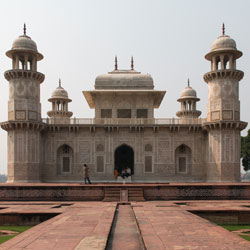
About The Itmad-Ud-Daulah in Agra The Itmad-Ud-Daulah, also known as the Baby Taj, is a Mughal mausoleum located in Agra, India. It was commissioned by Nur Jahan, the wife of Emperor Jahangir, in memory of her father Mirza Ghiyas Beg. This beautiful monument is often considered a draft of the Taj Mahal due to its intricate design and fine marble work. Timings Of Itmad-Ud-Daulah The Itmad-Ud-Daulah is open to visitors from sunrise to sunset every day of the week. Entry Fee The entry fee for visiting the Itmad-Ud-Daulah is INR 310 for foreigners and INR 40 for Indian nationals. Required Time And Restricted Items It is recommended to spend at least 1-2 hours exploring the Itmad-Ud-Daulah. Pets, food, and large bags are not allowed inside the monument. Architecture Of Itmad-Ud-Daulah The Itmad-Ud-Daulah is known for its intricate carvings, inlay work, and use of semiprecious stones. The tomb is set in a Persian-style garden with red sandstone walls and white marble decorations. Best Time To Visit The best time to visit the Itmad-Ud-Daulah is during the winter months from October to March when the weather is pleasant and ideal for exploring the monument. How To Reach The Itmad-Ud-Daulah is easily accessible by road from Agra city. Visitors can hire a taxi or take a local bus to reach the monument. The nearest railway station is Agra Fort, and the nearest airport is Agra Airport. History Of Itmad-Ud-Daulah The Itmad-Ud-Daulah was built between 1622 and 1628 and is considered one of the earliest examples of Mughal architecture in India. It is believed to have inspired the design of the Taj Mahal. Inside Itmad-Ud-Daulah Inside the Itmad-Ud-Daulah, visitors can see the tomb of Mirza Ghiyas Beg and his wife Asmat Begum. The interior is adorned with intricate marble work, floral designs, and geometric patterns. Traveling Tips It is advisable to wear comfortable footwear and clothing while visiting the Itmad-Ud-Daulah as there is a fair amount of walking involved. It is also recommended to carry water and sunscreen, especially during the summer months. Hotels Near Itmad-Ud-Daulah Some of the hotels near the Itmad-Ud-Daulah include: 1. Taj Hotel 2. Oberoi Amarvilas 3. ITC Mughal 4. Trident Agra 5. Radisson Blu Agra Nearby Tourist Spots of Itmad-Ud-Daulah Some of the nearby tourist spots of the Itmad-Ud-Daulah include the Taj Mahal, Agra Fort, Mehtab Bagh, and Jama Masjid. Visitors can explore these attractions to get a deeper insight into Mughal history and architecture.
Explore More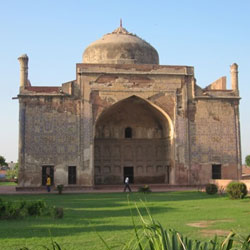
The Chini-Ka-Roza Tomb is a memorial of Allama Afzel Khal Mullah of Shiraz, who was a poet-scholar. He was the prime minister of the famous emperor Shah Jahan. The tomb surface is decorated with various glazed tiles.
Explore More
About The Sheesh Mahal The Sheesh Mahal, also known as the Palace of Mirrors, is a stunning architectural marvel located in Agra, India. This beautiful palace is part of the Agra Fort complex and is known for its intricate mirror work and stunning craftsmanship. Constructed during the Mughal era, the Sheesh Mahal is a must-visit for history buffs and architecture enthusiasts. Timings Of Sheesh Mahal The Sheesh Mahal is open to visitors every day of the week from 6:00 AM to 6:00 PM. It is recommended to visit early in the morning to avoid the crowds and to enjoy the palace in a peaceful environment. Entry Fee The entry fee for the Sheesh Mahal is INR 50 for Indian nationals and INR 500 for foreign tourists. Children below the age of 15 can enter for free. Required Time And Restricted Items It is recommended to allocate at least 1-2 hours to fully explore the Sheesh Mahal and admire its intricate beauty. Visitors are not allowed to carry large bags, food items, or camera tripods inside the palace. Architecture Of Sheesh Mahal The Sheesh Mahal is known for its exquisite mirror work, where the walls and ceilings are covered with intricate mosaic patterns created using tiny pieces of colored glass and mirrors. The palace also features beautiful carvings, paintings, and lattice work that showcase the skilled craftsmanship of the Mughal artisans. Best Time To Visit The best time to visit the Sheesh Mahal is during the winter months from October to March when the weather is pleasant and ideal for exploring the historic sites in Agra. How To Reach The Sheesh Mahal is located within the Agra Fort complex, which is easily accessible by road from various parts of Agra. Visitors can hire a taxi, auto-rickshaw, or take a local bus to reach the Agra Fort and then explore the Sheesh Mahal within the complex. History Of Sheesh Mahal The Sheesh Mahal was built during the reign of Emperor Shah Jahan in the 17th century as a private palace for the royal family. It was used for special occasions and as a retreat for the emperor and his close associates. The palace reflects the opulence and grandeur of the Mughal era. Inside Sheesh Mahal Inside the Sheesh Mahal, visitors can marvel at the intricate mirror work that adorns the walls and ceilings of the palace. The reflection of light creates a mesmerizing effect, making it a truly magical experience for visitors. The palace also offers stunning views of the surrounding Agra Fort complex. Traveling Tips It is advisable to wear comfortable footwear as visitors need to walk around the palace complex. It is also recommended to carry a bottle of water and sunscreen, especially during the summer months. Hiring a guide can enhance your experience and provide valuable insights into the history and architecture of the Sheesh Mahal. Hotels Near Sheesh Mahal There are several hotels near the Sheesh Mahal that offer comfortable accommodation options for visitors. Some of the popular hotels include: 1. Hotel Taj Resorts 2. The Oberoi Amarvilas 3. Jaypee Palace Hotel & Convention Center 4. ITC Mughal, A Luxury Collection Hotel 5. Hotel Clarks Shiraz Nearby Tourist Spots Of Sheesh Mahal After visiting the Sheesh Mahal, visitors can explore other nearby tourist spots in Agra, including the iconic Taj Mahal, Agra Fort, Fatehpur Sikri, Akbar's Tomb, and Mehtab Bagh. These attractions offer a glimpse into the rich history and cultural heritage of Agra and are worth exploring during your visit to the city.
Explore More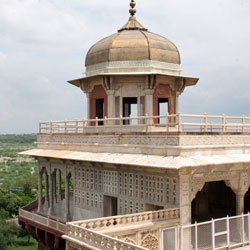
Shah Burj, Agra is one of the most amazing places to visit when planning a trip to Agra. Shah Burj is one of the striking destinations in Agra that is applauded for its overall grandeur. If you are going to explore the beauty of Taj Mahal from it for the first time, we are sure there would be a sort of adrenaline rush, courtesy the overwhelming experience. One of the most interesting facts about Shah Burj is that Shah Jahan spent last days of his life here at this Burj. Shah Jahan was not alone during his last days after being imprisoned by his son, Aurangzeb, but was with his daughter whose name was Jahanara Begum.Architecture:It is also to be mentioned here that Shah Burj is also known as Musamman Burj. Shah Burj is an octagonal tower which lies in close proximity to Shah Jahan’s private hall, Diwan-i-Khas. Shah Burj, Agra is a multi-storied marble tower, which gives amazing Yamuna river views. Shah Burj or Musamman Burj is widely known for its tical pillars, horizontally shaped chajjas supported by lovely brackets, a jharoka on its eastern side as well as a marble screen on the riverfront. There is no denying the fact that one will be awestruck by the beauty of Shah Burj in no time.Traveller Information:Shah Burj, Agra boasts of separate entry fees for both Indian and international tourists. While Indian tourists have to pay 40 INR, international tourists, on the other hand, are supposed to pay 550 INR. There are no entry charges for children below 15 years of age.Best Time to Visit:Shah Burj or Musamman Burj is open and can be visited all around the year. Since it is located in the state of Uttar Pradesh, the summers are very hot with an average temperature up to 42 degree Celsius. The ideal time to visit this fort is during winters as it very cool and pleasant during those months and are said to be perfect time for sightseeing.How to Reach:People who are travelling via air, the nearest airport is Agra's Kheria airport, which also has military base. Those who are coming over through bus, Agra is one of the well-connected cities of India with major other cities such as Delhi, Jaipur, Gwalior, Lucknow and Kanpur. For those who are travelling via rail, there are five railway stations namely, Agra Cantt. Station, Raja ki Mandi, Agra Fort Railway Station and Idgah Railway Station.Interesting Facts:One of the most interesting facts about Shah Burj is that Shah Jahan spent last days of his life here at this Burj. Shah Jahan was not alone during his last days after being imprisoned by his son, Aurangzeb, but was with his daughter whose name was Jahanara Begum. Shah Burj offers some of the striking views of Taj Mahal as well.Nearby Attractions:• Taj Mahal• Fatehpur Sikri• Akbar's Tomb• Agra Market• Jama Masjid
Explore MoreMathura Goverdhan Barsana Car Tour
1 Day
Mathura - Vrindavan
5N/6D Spiritual Triangle with Naimisharanya
6 Days/ 5 Night
Lucknow - Ayodhya - Prayagraj - Varanasi - Sitapur
7N 8D Luxury Religious Travel Plan Tour
8 Days/ 7 Night
Prayagraj - Mirzapur - Varanasi - Ayodhya - Sarnath - Chitrakoot
2D - 1N Agra Tour Package
2 Days/ 1 Night
Agra

Museums are one of the most exciting and interesting places to visit especially if you love to get more knowledge and gain expertise in some things. While the Taj Mahal is one of the greatest wonders of the world, there is one place inside this symbol of romance that most people tend to miss out on. This is the Taj Museum situated within the complex of the mighty Taj Mahal. Located in the western ends of the Taj complex is the exciting museum that houses all the information you would want to know about the Taj Mahal. When you travel a little inside from the Jal Mahal, you will find the Taj Museum there. Before visiting the Taj Museum, Agra, here are some things that you might want to know.Traveler TipsAll those who are planning to make a visit to the beautiful city of Taj or the epitome of love, the epic Taj Mahal, do not forget to visit this interesting Taj Museum. Travelers must carry their excitement with them when visiting here to grasp as much knowledge from this museum about the Taj Mahal as possible.Things to DoThere are similar things to view in general any museum you visit and the Taj Museum is no different. However, unlike other museums with boring historic stuff, you will be mesmerized by the exciting knowledge you will get about the Taj. You can roam around staring at the beautiful artifacts that are located inside the museum. You can get a closer look at the blueprints of the art and artifacts that were used during the construction of Taj Mahal. Whether you are a romantic person, a history buff, or a lover of architecture, you will find everything to suit your requirements at this museum. There are two galleries in the mighty Taj Museum that show the construction of Taj and the other shows the porcelain objects from that time. There is a third gallery as well where you can see the documents, calligraphy works, farmans, and much more from that era.AvailabilityThe Taj Museum is open on all days of the week except for Fridays. You cannot access the Taj Museum on Fridays. Apart from that, the timing for the Taj Museum is from 10 in the morning to 7 in the evening. You can purchase an entry ticket of 20 rupees if you are an Indian and of 750 bucks if you are a foreigner to enter into the gorgeous museum.HistoryThe Taj Museum was established in the year 1982 and has been offering insights about the mighty Taj ever since. While the Taj Mahal has been in its existence ever since it was constructed by 20,000 workers in the 17th century by the then Mughal ruler Shah Jahan, the Taj Museum was constructed much later.How to ReachThis museum is located right inside the Taj Complex which houses one of the seven wonders of the world- the Taj Mahal. You can reach Agra very easily via flights, trains, and even during the road. It is seamlessly connected and welcomes international tourists from all parts of the world. When you are in Agra, you can hire tongas, bullock carts, electric rickshaws, or tempos to reach the Taj. You need to part your vehicle inside the parking lit which is at some distance and reach from there to the Taj Complex. You can even take private cabs or taxis or the state buses to reach the beautiful Taj complex from the Agra airport, Agra Cantt Railway station, or any other major bus terminal there.
Explore More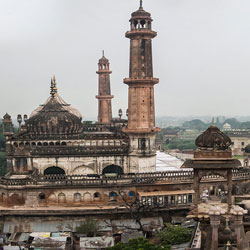
Uttar Pradesh is an important state of India and played a significant role in the expansion of British rule in the country. The East India Company get associated with some of the famous Awadh rulers during the rule of third Nawab of Awadh and succeeded in establishing the foothold in the place. Under the British reign, some of the most magnificent structures constructed in Uttar Pradesh. Inspired by the Gothic and the ancient, traditional neoclassical styles of architecture, the monuments and structures in the state are built magnificently.Architecture Of Colonial Monuments:It is not difficult for tourists to find the colonial monuments in Lucknow during their heritage tours. Like other architectural styles that have inspired from styles taken from abroad and then blended with the traditional style of the region, the European design also fused with the Indo-Islamic architectural style to build the colonial monuments in Lucknow. This particular architectural style is also known as Indo-Saracenic architecture. Tourists can observe this architectural style in most of the churches, palaces, residential quarters, educational institutions and government buildings.Highlights Of Colonial Monuments, Lucknow:Tourists can explore Raj Bhavan, one of the colonial monuments found in Lucknow. This structure was designed by Major General Claude Martin. This monument was served as the official residence of the Governor of the united provinces of Oudh and Agra. Lucknow also houses other colonial monuments that were constructed during the colonial era like Dilkusha Palace, The Residency, La Martiniere School and Lalbagh Methodist Churches and many more.Best Time To Visit:Lucknow is quite hot during the summer season, experience temperatures about 40 degrees Celsius to 43 degrees Celsius. If you can manage the heat then you can plan a tour to these colonial monuments during the summers. In the winter season, even though the climate remains cool and pleasant, it creates the appropriate conditions for exploration and sightseeing. So, the best time to explore these colonial monuments is winter season i.e., between the months of November to February.Nearby Tourist Attractions:During a visit to colonial monuments in Lucknow, tourists can explore some other places of interest in this city. The places of interest other than colonial monuments one can explore in Lucknow are Bara Imambara, Hazratganj, Chota Imambara, Nawab Wajid Ali Shah Zoological Garden, etc.How To Reach:Lucknow is well connected with different parts of India via a good network of trains, flights, and buses. Lucknow Airport at Amausi connects the town with other parts of the globe via a number of flights. Those who prefer traveling by train can reserve their tickets till Charbagh railway station in Lucknow. One can also take state and private buses from nearby towns and cities to reach Lucknow. Once you reach Lucknow, you can access all the colonial monuments located in the city via taxies, cabs, buses and other vehicles.Additional Information For Visitors:The entry fee to the colonial monuments in Uttar Pradesh depends on the monument you are going to visit. For visiting Dilkusha Palace, domestic tourists need to pay Rs. 5/-, while international tourists need to pay Rs.100/-. For visiting churches, one doesn’t have to pay any entry fee, while visiting colonial monuments that are now serving as government offices, one need to pay a nominal entry fee.
Explore More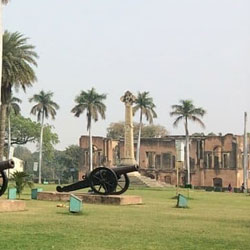
Lucknow is well known for its Chikan embroidery, Islamic monuments and tehzeeb. One of the historic places that have made this place famous is Residency in Lucknow. Residency Lucknow is best recognized as the alive residences of the British General- the symbol of the British East India Company. He was functional in the courts of nawabs. The place showcases the grand life led by the British. One can also sense the freedom struggle and the siege this place witnessed. The Residency, Lucknow, is an integral part of the city and a must-visit place for all the touring enthusiasts. History of Lucknow Residency, Lucknow Lucknow Residency is chiefly a group of structures that were constructed in 1800 A.D by the then Nawab of Oudh, Nawab Saadat Ali Khan. It was primarily built to serve as the living place for the British Resident General who was illustrative in the court of Nawab. Description of Lucknow Residency, Lucknow Lucknow Residency was relatively a sleepy residence for periods but then came an occasion, which kept on the world map. The story of the siege of 'The Residency' in Lucknow will go depressed in the history of India as a daring attempt done by a handful of men, women and children to aggravate the efforts of mutineers. The residence of the palace seized together through the continuous gunfire that lasted for a month. The cannonballs shrank the walls of Residency, but the castle detained extraordinarily. Sir Henry Lawrence who wiseacre the charge of 3500 human lives commenced the defence and counter ingenuity. On the last day, the blockade brave hearts submitted and fall. The bolstering force saved the palace in 5 months. In latest times the redbrick ruins of Lucknow Residency are serenely bounded by lawns and flowerbeds, but thousands died through the month-long siege. The Residency has been preserved as it was at the time of the final release, and the distressed walls are still damaged by a cannon shot. Even then, Independence, things have not altered. A frightening silence submerges the ruins. The graveyard at the nearby crumbling church has the graves of 2000 men, women and children, and that of Sir Henry Lawrence who expired protecting the empire. There is a damaged epitaph near the grave of Sir Lawrence that says 'Here lays the heir of Empire who attempted to do his duty'. Lucknow Residency in Lucknow is situated near Gomti banks nearby Begum Hazrat Mahal Park. The park is open throughout the year. Book a cab or auto from the hotel or take a rickshaw to look at one of the main monuments in Lucknow. When to visit Residency, Lucknow During monsoon- this is the ideal time to visit Lucknow as adequate rainfall takes place in the city and weather stays enjoyable. Also, the hotness during rain stays normal. During Winters- the nights are cold and foggy, but the temperature remains best 7 degrees to 24 degree Celsius. During this time one can visit all tourist spots without any discomfort. Other nearby attractions in Lucknow Lucknow's topmost attractions other than Residency Lucknow are • Hazratganj, • Bara Imambara, • Chandrika Devi Temple, and • St. Joseph's Cathedral etc. Traveller's tips • The ticket to Residency Lucknow is INR 5, and anyone can visit the place between 10 am to 5 pm. • Carry comfortable clothes and shoes, a lot of walking has to be done there. • In summers, umbrella, cap and sunscreens are musts. For winters light woollen clothes are recommended. • For making the visit interesting as well as informative, hiring a travel guide is advised. • Beware of crumbling structures.
Explore More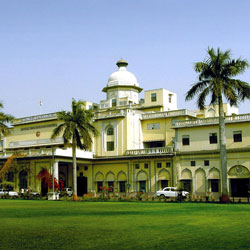
Lucknow is the capital of Uttar Pradesh and it is also the abode of a multicultural society. Thinking of Lucknow, you will remind of Nabobs and popularly known as the city of Nawab. It is also the city for administrative, education, commerce, aerospace, finance, culture and poetry. Lucknow is used to be the capital of Awadh state and it used to be controlled by Delhi Sultanate. It is one of the Legend cities and it is believed to be named after Lakshmana. Chettar Manzil is one of the places to visit in Lucknow. Chattar Manzil, Lucknow is commonly known as Palace with Umbrella and it was built by Nawab Ghazi Haider and it is located on the river Gomti. Traveller Tips: Lucknow is the city of historical and societal significance. Lucknow is a city of monuments and it is even popularly known as Tehzeeb and Nawabi. So you can there are lots of things to do in Lucknow. If you are in Lucknow do visit Chattar Manzil, shopping places, food eateries, etc. Things to Do: Lucknow is the city of great Nawabs and various architectures, with lots of moghals cuisine. Hence there are lots of places where you can visit the remarkable architecture of Nawab’s era in Lucknow. There are places where you can enjoy your trips such as Bara Imambara, Gomtinagar Marine Drive, and Heritage sites and also enjoy the fabulous Kebabs and Kulfis with lots of shopping and many more. Availability: Lucknow is a land of cuisines and variety of food is readily available. Since Lucknow is multicultural various foods are available from kebabs to Jain food. Various delicacies of Lucknow are famous such as Tunday kebabs, Biryani, sweets, chaats and many more. There are lots of restaurants that are offering both vegs as well as non-veg foods at reasonable rates. History: It is also believed by historians that Palace was constructed in remembrance of Chattar Kunwar. Extremely impressive architecture is famous in Lucknow, and Chattar Manzil is one of them that takes us back into history sites of Nawabs of Lucknow. The meaning of the term Chattar is Umbrella and Chattar Manzil is covered with Umbrella and it is commonly known as Palace with Umbrella. Its foundation stone was laid by King Ghaziuddin Haider was better known as Nawab and later his successor, Naseeruddin completed the Palace. Chattar Manzil is used by the Government of Uttar Pradesh as Museums and library at the Palace. Architecture: One of the most remarkable structures constructed by Nawabs is Chattar Manzil and it is also a great attraction for tourists. This is an excellent architectural example of a combination of Indian and European architectural design. This historical Palace boasts a beauty of great architecture in the world. Chattar Manzil is a five-storied building and also has two floors under the ground. The Palace has a beautiful garden which was destroyed earlier. Festival: Lucknow is known as the City of Nawabs and even Lucknow is a land of multicultural which makes Lucknow celebrate all the Festivals in a much splendid way. There are lots of Festivals in Lucknow but prominent among them are Diwali, Holi, Eid and Dussehra Festival. However, there are 12 months but more than 12 festivals are celebrated in Lucknow. Diwali is celebrated splendidly and traditionally to date and whole Lucknow is decorated with thousands of diyas. During Diwali giving gifts has been traditionally continued. Popular Culture: The culture of Lucknow is still active and they are known for their cosmopolitan traditions. Lucknow has a rich culture of mouth-watering cuisine, music, fine arts, and most important courteous people. The people of Lucknow are known for well behaved and humble and they treat their guests as gods. Lucknow is also known for music which is influenced by Mughals. The most eminent language used in Lucknow is Urdu, however, Hindi is most commonly used in Lucknow. Lucknow is also famous for Chinkari which is traditional embroidery used on apparel. Best Time to Visit: The best time to visit Lucknow is during winters as summers highly uncomfortable to visit. So the best time to visit in and around Lucknow is October to March. Monsoon is also considered to be moderate time from July to September. The temperature remains pleasant comfortable for sightseeing. However, timings for visiting Chattar Manzil are from 8.00 a.m. to 6.30 p.m. The time required to visit Chattar Manzil, Lucknow is 1hour. So it is advisable to visit early so that the palace can be seen comfortably. There is no entry fee for visiting this beautiful building. How to Reach? To reach Chattar Manzil which is located 6.4 kilometres from Lucknow Junction Railway Station. There are well-connected trains from every Metro station and very well connected with every major city of India. To reach Lucknow one has to reach Chaudhary Charan Singh International Airport. This Airport is directly connected to every major airport. International Tourist is connected through Lucknow which is mainly connected with major Indian cities like Delhi, Mumbai, and Kolkata, etc. However, to reach Chattar Manzil Lots of Buses, Taxis, autos are available. To reach Chattar Manzil nearest bus station is Kaiserbagh bus station and Parivarthan Chowk Bus stop. Interesting Facts and Trivia About: Lucknow is one of the most prominent tourist places visited not only within India but also from outside India. It is immensely popular for its architecture, hospitality, and cuisine. From its lazeez biryani to kebabs every dish is distinctive. Lucknow is also famous for Bara Imambara. It is also believed that these Imambara have huge tunnels which may lead to Agra. Chattar Manzil has a huge gold umbrella and which can be seen from distance also. Nearby Attractions: Bada Imambara(Big Maszid) Bada Imambara is situated on the bank of the Gomti River. It is a historical tomb and considered too big hall meant for muslims for religious prayers and rituals in 1784. The big mosque has beautiful architecture having the design of the Mughal era. It has also a central chamber which consists of the tomb of Asafud Daula. British Residency Lucknow has various sightseeing sites such as Lucknow residency which is better known as British Residency. This Residency shows glimpses of the colonial era. This residency has a landmark of bullets and shots of cannon. The building also has beautiful museums that display its beautiful architecture. Rumi Darwaza A magnificent architecture close by Chattar Manzil in Lucknow is Rumi Darwaza, which has a height of about 60-foot tall which is also near to Bada Imambara. This elegant dome-shaped gateway is located centrally to Lucknow. It was built in the 18th Century and famous for carvings and architecture. It is also called Turkish Gate as it has a similarity of gate placed in Istanbul. Thus Lucknow is gifted with beautiful architectures, cuisines, art, and crafts. Thus don’t wait and pack your bag and make your plan to visit Lucknow, a beautiful place to spend some time with your family, friends and feel the glimpses of the Awadh era. Lucknow has beautiful tourism attractions of Bada Imambara, Chattar Manzil, and many more. Thus make sure you should not miss your lifetime opportunity.
Explore More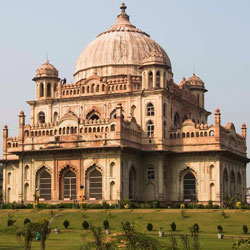
Tombs Of Saadat Ali Khan & Khurshid Zadi
Visiting the Tombs of Saadat Ali Khan and Khurshid Zadi will be an experience of great delight for tourists like you as it is grand and amazing in their way. These tombs are popular tourist spots in the state of Lucknow. These are known for its beautiful garden and intricate architecture. It is located near to the Begum Hazrat Mahal Park and it is built on account of the fifth Nawab Saadat Ali Khan and his favourite wife Khurshid Zadi. Among all the other wives of Nawab, she used to be the most loved and liked by the Nawab who died when he was alive. From 1794 to 1814 AD, Saadat Ali Khan was the ruler of Awadh and he built several beautiful and dotting monuments during this time. The credits for Dilkusha and Qaisar Bagh goes solely to him. At the time of his rule, the British Empire too was making its way and captured half of the city of Lucknow. They were growing stronger day by day. You won’t be able to love your eyes from the other beautiful moments here like the Chhota Imambara and Bara Imambara present nearby. You will get to see what you had been missing all this time after you visit this the Tombs Of Saadat Ali Khan and Khurshid Zadi, Lucknow. Things To Do There are several things that one can do after their visit to the beautiful Tombs of Saadat Ali Khan And Khurshid Zadi, Lucknow. You will get to see the true shadow of what is Incredible India here in Uttar Pradesh Lucknow. This is depicted by their pilgrimages, culture, food, craft, and other such things. The iconic Taj Mahal in Agra. With its wide array of beautiful and popular tourist attractions, Uttar Pradesh never fails to surprise you. At one side of the state, you will get to see the spiritual side and on the other, you will get a gourmet experience of exemplary render. There are several things to count on when you visit Uttar Pradesh. You will be happy to see the celebration of Holi in the city of Barsana and Vrindavan. You will also get to imbibe the spiritualism and the beautiful Ganga Ghat which looks amazing in the evening. The capital city of Uttar Pradesh is Lucknow which offers you a different side of the State. The city has a plethora of experiences for you without hampering the true essence of tourism. From the chic cafe culture to the architectural gamut, to the Chikankari work to the Mughlai food, in Lucknow, you will get great food to satisfy your appetite. Architecture The tombs of Saadat Ali Khan and Khurshid Zadi, Lucknow is said to be one of the most famous places. The architecture is the reason why it is claimed to be so. The walls of this tomb are built with Lakhuri bricks or better known as the burnt clay bricks, floors are made up of sandstone and the facade is well decorated with the help of Lime plaster. As you enter the Tombs of Saadat Ali Khan and Khurshid Zaid, Lucknow, you will get to see a rectangular verandah that is carved intricately and the doorways are arched. On the south and east parts of this place are the graves and tombs of the other wives and the daughters. The floor of the tomb is elegant due to the black and white coloured marble that is placed beautifully giving it a great pattern like a big chessboard. Apart from the other features of the tomb what attracts the most is the hemispherical dome. It has a symmetrical shape and attracts the tourists more because it is topped with an inverted lotus as a final touch. To know the exact place where the tombs of the two rest you need to follow the rectangular design in the centre of the hall. There are three other graves including the Nawab and his brothers. To the east of Nawab's tomb is his wife, Khurshid Zaid's tomb. Though the structure is of four levels still the level of the graves of mother and daughter is the same. On the corners of both the domes are chhatris of octagonal shape which increases the beauty of the Tombs of Saadat Ali Khan and Khurshid Zadi, Lucknow. Best Time To Visit The tombs of Saadat Ali Khan and Khurshid Zaid is in the state of Uttar Pradesh and the city of Lucknow. The best time to visit depends on your holidays and your preferences. But the weather of this place in summer is quite high and it is near to 42 degrees Celsius. The heat can cause a problem as you won’t feel like travel as you will be sweaty and tired. Therefore, if you prefer to travel and explore then visiting the place in cold and pleasant weather during winter is best. How To Reach? Uttar Pradesh is a state that is developing its infrastructure day by day. It is getting well connected to the rail, road, and air and it is becoming fairly a tourist attraction. Though if you wish to travel, road and rail is the best way to visit UP. Most of the parts of this state are easily accessible from the national highways and have great connectivity through railways. It also has decent air connectivity. Two international airports and four domestic airports connect the place to the rest of the country. By train: Railways is a great option for you to visit the state of Uttar Pradesh. There are around 430 railways stations that are functional and helps you reach the tourist destination. Some of the best railways are Kanpur, Varanasi, Lucknow, Agra, etc. By Air: Chaudhary Charan Singh is the international airport of UP. It is in Lucknow. Another one is the Lal Bahadur Shashtri Aiport, Varanasi. Some domestic ones are Kanpur, Agra, Jhansi, etc. By Road: The easiest way to reach UP is roadways. National highways like NH 19, NH 21, NH 30, NH 34 and Yamuna Expressway connected the place well enough. Choose any way as your presence and visit Tombs of Saadat Ali Khan and Khurshid Zaid, Lucknow in your holidays.
Explore More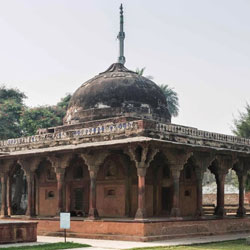
The capital city of UP (Uttar Pradesh) is a den of people, smells and sounds. But if have not visited this fascinating, electrifying and delightful city, you have missed a great opportunity to make yourself entertained in an unique way. Lucknow, the ‘city of nawabs’ is a diverse city that had started receiving prominence from the end of 18th century. During the reign of Awadh’s nawabs this place became a famous center of culture and art. The skyline of the city is a captivating array of buildings which are having a diverse range of architectural styles that is rooted back in the Mughal era. Lucknow is a popular name due to its different facets of cultural heritage including music, poetry and embroidery, which are flawlessly tangled with finance, pharmaceuticals and modern technology. 'Muskuraiye ki ap Lucknow mein hain'! This majestic city is full of royal palaces, historic spots, ancient temples, high-tech shopping malls, magnificent museums, delicious food and architectural marvels. If still you have not enjoyed the warm hospitality of this city, you must plan for it at least once in your life. And, if you are in the nawab’s city, don’t miss out an opportunity to visit Nandan Mahal, Lucknow. Description: The history of Nandan Mahal can be traced back in the time of Mughal ruling. It is another catacomb in the history of Lucknow. This is one of the eldest surviving monuments in Indian history which is devoted to the memory of Shaikh Ibrahim Chishti, who was the first governor of Mughal India, during the reign of Akbar. Though it is less discovered among the tourists come to visit Lucknow but it is one of the most serene tourist destinations of the city. Traveller Tips: • No entry fee is required. • As it is situated in between a public park, it remains open all seven days a week. • Timings for visit is between 6 AM and 10 PM. Architecture: Nandan Mahal, Lucknow is situated in old Lucknow, in a park backdrop. The park complex holds three structures and among those two are encircled tombs. Between those two tombs, one includes the remnants of Shaikh Ibrahim Chishti. As the tomb was constructed during the Mughal era, it holds the architectural design patterns of the Mughals. The surrounded bays within the monument are panelled and sunken. The architectural structure of this historic building includes framed shades which cover the entrances in the east, west and north directions. But the entry to the south side, which is the main entrance for the chamber, is decorated with a huge sized stone tablet that is having three Nastaliq styled Persian couplets. The roof of the mausoleum is designed with a lotus leaf ornament on its top. And, the drum of the roof is octagonal shaped which brags with green and blue coloured tiles. Best Time to Visit: Summer – if you are planning trip during the summer, restrict your planning in between March and April. After that temperature here rises and normally crosses the limit of 45 degree Celsius. Winter – winter here is pleasing and sunny too except for the nights which remain foggy and icy. More or less, you will love a visit here during this season. How to Reach? Lucknow is well connected with roadways and railways with the rest of the country. You can easily hire a bus service or cab to reach here from any part of India. Also, from any major cities of India, you can get a flight to reach Lucknow airport. Interesting Facts and Trivia About: After the death of Shaikh Ibrahim Chishti, his followers used visit his tomb regularly for deliverance (nandan) of his soul. Since then this place became known as Nandan Mahal. Nearby Attractions: You can easily visit a number of nearby places of Nandan Mahal after visiting this place, including – • British Residency • Bara Imambara • Lucknow Zoo • Chota Imambara • State Museum Lucknow • Chattar Manzil • Dr. Ambedkar Park • Hussainabad Picture Gallery • Indira Gandhi Planetarium • Begum Hazrat Mahal Park • Maa Chandrika Devi Temple • Hazratganj • 1857 Memorial Museum • Rumi Darwaza • Jama Masjid So, if you are passionate of exploring historial places, monuments and the history buried in their backdrop, you love visiting Nandal Mahal and Lucknow. You also enjoy tasting the food here which is another specialty of this city of nawabs. Plan your trip soon!
Explore More
Long back from the era of Mughals, Nawabs and Britishers, Lucknow is celebrated to be dotted from those structures. One amongst the most highlighted places of Lucknow happens to be the Vidhan Sabha or also known as Vidhan Bhawan or state assembly. Vidhan Bhawan, Lucknow is an amazing exemplar of Indo-European architecture, having some of the outstandingly amazing Gothic elements at the same time. There is no denying to the fact that Vidhan Bhawan, Lucknow is a synonym to a palace. Moreover, it is worth mentioning that the Bhawan is decked up like literally on special occasions such as Republic Day or Independence Day. During these days, the Bhawan is a sight to behold. Architecture: As we have already mentioned in the aforestated paragraph that Vidhan Bhawan, Lucknow is a perfect representation of Indo-European architecture date back to the 20th century. The Bhawan is structurd as a two-storeyed palace that is in a crescent shape. Brought all the way from Mirzapur, Vidhan Bhawan is carved with striking light brown sandstone blocks, which is also known as Chuna or Chunar. In addition to this, the Gothic styled dome is right in the middle of the lavish structure. Best Time to Visit: Vidhan Bhawan or Vidhan Sabha or majorly known as the state assemble in Lucknow can be visited during anytime of the year. It completely depends on the tourists when they would like to visit and explore the honourable destination. In addition to this, we would also like to tell you that summers can witness a lot of temperature here ranging up to 42 degree Celsius, which can be a put off for you. Probably winters would be hassle-free for the weather is pleasant during that time. Rest it is up to you. How to Reach: Vidhan Bhawan is located on the land of Lucknow that is situated in Uttar Pradesh. This Indian region is very well connected with major other parts of the world. So, for those who are travelling via rail, Lucknow Junction Railway Station happens to be the major junction of the place. After this, you can hire cab that would take you to Vidhan Bhawan within for over 11 minutes. For the ones who are travelling via air, Chaudhary Charan International Airport would be the one for you that happens to be for over 15.5 km away from Vidhan Sabha. From here on, you can opt for a cab or taxi, which will take for about half an hour’s drive. The ones who are travelling through road can be overjoyed for Lucknow is very well-connected via roads. If we specifically talk about the proximities then Lucknow is 316 km drive from Jhansi, 86 km from Kanpur, 280 km from Varanasi and 323 km from Agra. Via NH 27, one can easily reach Vidhan Bhawan, Lucknow from Kanpur. People coming from Varanasi will have to go for NH 30. And travellers coming from Agra can opt for Agra Lucknow Expressway. Nearby Attractions: Below are some of the famous nearby attraction that one must explore when planning a trip to Lucknow: • Jain Temple • Lord Hanuman Temples of Aliganj • Sikandar Bagh • La Martiniere • Buddha Temple • Shaheed Smarak • Dilkusha • Gurudwara Yahiyaganj • National Botanical Research Institute
Explore More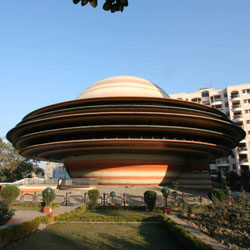
Lucknow, the land of the nawabs, is not just famous for the mouthwatering food, beautiful palaces and structures, and the friendly nature of the people. There is much more to Lucknow than you can ever imagine. And one thing that sets Lucknow apart from all other cities and gives all the tourists a taste of different Lucknow is the Indira Gandhi Planetarium, Lucknow. When you are traveling with your kids, this planetarium becomes a must to visit the place. It has all the essential information and details that one could need to know about astronomy. It is a fully air-conditioned planetarium where you can catch astronomical shows and learn about the universe, the movement of planets, satellites, stars, other planetary objects. Even the building of the planetarium itself is shaped like Saturn which makes it quite beautiful and scintillating to enter. Traveler Tips If you are traveling to Lucknow, traveling to the Indira Gandhi Planetarium is a must. All the travelers need to follow just some very simple tips to make sure they have everything sorted for their visit. They can find about the entry fee that is around Rs. 25 per person in India. Apart from that, if you visit the museum in a group of over 30 people, you will only be charged at the price of Rs. 10 per head. The next thing that you need to know is the timing of the planetarium. It is open from 10 in the open and stays open for all tourists till 5 pm. It stays shut on Monday so avoid visiting on this day. You can also attend the show that takes place four times a day for all the visitors. The timings of the show are 1:00 pm, 2:30 pm, 4:00 pm, and 5:00 pm. This show lasts for around 35-45 minutes. Things to Do You can go around the planetarium and explore the interesting things placed inside. There are many variations of the Indian satellites you can see there and learn about them. You can also find a lot of information and details about many of the Indian scientists like Varahamihira, Aryabhatta, etc. The 3D space above would also let you take a stroll in the endless space. The aspiring astronomers and students can learn a lot about planets and other planetary objects in this planetarium. History This Planetarium was incepted in the year 1988 by the Late Chief Minister of Uttar Pradesh- Veer Bahadur Singh. However, it was in 2003 when the planetarium opened its gates to the regular public. The inauguration of the planetarium was done by the then Chief Minister Ms. Mayawati. Architecture The architecture of the Indira Gandhi Planetarium is also worth watching. The main building of the planetarium is in the shape of the beautiful planet Saturn and even has the stunning rings. Apart from that, the entire planetarium precinct is bordered by water bodies. Best Time to Visit While the planetarium is fully air-conditioned and can be visited at any point in time, it is believed that the best time to visit it is when the kids have their summer vacations. This is the time when kids enjoy the most and the planetarium even has an extra screening of the cosmic show at 6 pm in the evening. How to Reach Located in the Vigyan Bhawan, Surajkund Park area of Lucknow in Uttar Pradesh, it is very easy for travelers from any part of the city to reach the planetarium. All you need to do is reach the capital city. It has its own Railway junction, airport, and seamless road transport connecting all.
Explore More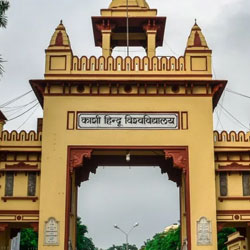
Banaras Hindu University, Varanasi is one of the fabulous learning centres in India with an international reputation. It is also called as BHU in short where many nation builders and great freedom fighters were developed. This supreme learning centre has developed a large number of celebrated scholars, artists and scientists. Hence, it has contributed commendably in the development of our country. It also has a highly rated structure among all monuments in Varanasi. History of Banaras Hindu University, Varanasi Banaras Hindu University is in Varanasi, Uttar Pradesh. It was founded in the year 1916 by Pandit Madan Mohan Malaviya who was the great nationalist leader of India. Dr Annie Besant also played a substantial role in the formation of this University. More Details about Banaras Hindu University, Varanasi The Banaras Hindu University brags an extensive campus stretched to 1300 acres of land which has well maintained roads that are well maintained and cross each other at right angles. Find vast greenery within the premises of this University. A temple, an airfield and constructions are some architectural delights at this place. This place has -Big playgrounds, -A flying club, -A big auditorium and Several other services as well as facilities like • Subsidized Canteens, • Printing Press, • Fruit Preservation Center, • Employment and Information Bureau, • Security, • Publication Cell etc. Top 10 Specialities of Banaras Hindu University 1. Institutes in BHU The BHU consists of 3 Institutes. These comprise of • 14 Faculties spread across 124 Departments, • 4 Interdisciplinary Centers and • 3 Constituent Schools. 2. The Varanasi Banaras Hindu University also has • An engineering institute- Institute of Technology and • A medical college- Institute of Medical Sciences. 3. Subjects offered to Students A comprehensive range of topics are accessible at BHU • all branches of social sciences, • science, • humanities, • technology, • medicine, • performing arts and • fine arts 4. There are 6 centres of advanced studies too besides 10 Departments that are under the Special Assistance Program. 5. Several specialized Research Centers- a part of BHU. 6. There are 4 Degree Colleges as well in this city which are allied to the University. 7. The Bharat Kala Bhavan is a beautiful part of this city which is a popular art and archaeological museum. This houses a rare collection to see and a real treasure trove. 8. The University also contributes a well-developed sports foundation. 9. Numerous amenities for different sports and hobbies are offered at BHU. 10. This University has around 2000 teachers besides 5000 non-teaching staff. The Banaras Hindu University, Varanasi has 15000 students as its strength, coming from various walks of life, religions, castes and races. An important thing to note BHU has a large number of foreign students as well. A big count of these students come from Asia, Europe, the Middle East, the U.S.A., and Africa. If you want to see all these, book yourself for a tour to Banaras Hindu University, Varanasi as soon as possible. When to visit? People generally avoid travelling to Varanasi in summers, especially in May and June as they are considered the hottest. But monsoon practices the fall in temperature, and the real beauty of the city come in front in its drenched state. The tourists are dragged towards the freshness and charm of the place. Best time to visit Varanasi is during winter –November to March Being a traveller anyone can have the best trip to Varanasi by touring around the winter season. The reason is the pleasant temperature that ranges from 5 to 15 degrees Celsius. You can have double fun with the boat rides on the Ganga, visiting the different temples and exploring the vibrant city if the plan you tour to Banaras in the winter season. A few essential festivals of India fall around this time. One can take pleasure in the customs and rituals of the locals. How to reach BHU Varanasi? By Air Varanasi has Regular flights at its domestic airport which connects Varanasi to some of the most central cities in India. By Rail Varanasi is well linked by railways to some of the prime cities of the nation like Delhi, Kolkata, Mumbai and others. By Road Varanasi has an excellent road network that makes it well connected to several of the other important cities in Uttar Pradesh. Other than the state government buses some private buses and transport options are there that ply between Varanasi and the other main cities. You can also get some public means of transport quickly. Tourist spots in Varanasi 1. Ganga ghat to view Ganga aarti 2. Vishwanath temple 3. Bharat Mata temple 4. Durga temple 5. Tulsi Manas temple 6. Ram Nagar Fort 7. Tomb of Lal Khan 8. Manikarnika Ghat 9. Hanuman Ghat 10. Bharat Kala Bhawan You must plan the tour after reading detailed knowledge about the city. Plan online in advance from a reputed tour operator.
Explore More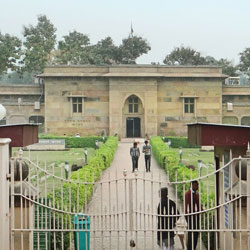
Sarnath in the state of Uttar Pradesh is one of the holiest site and a Buddhist Pilgrimage of India. This is the place where Buddha got his first sermon after he attained enlightenment. Along with some extensive and beautify ruins of Buddhist sites, this place also has numerous stupas, temples, ruins of some old monasteries, gardens, museums and other such interesting places. The archaeological museum in Sarnath is one of the most popular tourist sites to visit. It is the older of the Archaeological Survey of India. You will get to see some finest art embodiments of Buddhist here. Things To Do There are several things to do in Sarnath. It a place with holiness, beauty and several things are there for you to learn. You can visit the beautiful old monasteries that are built here, the gardens etc. You can also visit the Ganga Ghats in Varanasi, the ravishing Imambara in Lucknow and many more. Therefore after visiting Sarnath Museum, Sarnath, you should also visit the rest of the places in Uttar Pradesh and enjoy the most of it History Sarnath portrays some extensive ruins of Buddhism and has an interesting and rich history and heritage dating back to 528 B.C. After Buddha got enlightened at Bodh Gaya, he got his first preaching in the Deer Park, Sarnath. This place, therefore, is a great place to know about Buddhism and culture and teachings. At the end of the 12th century, Sarnath was destroyed by the Turkish Muslims. Since that time, the place is been lying with its ruins. The Sarnath Museum, Sarnath has an amazing and rich collection of artefacts, sculptures and edifices which comprises several Bodhisattva and Buddha images apart from the ancient relics. In 1904, the government decided to erect the Sarnath Museum, Sarnath to display and store the site excavations and findings and in the year 1910, the Archaeological Survey of India came into existence to preserve, study and display the antiques in every way possible. The museum in Sarnath is the oldest Archaeological Survey of India which comprises of the beautiful collection of some extravagant sculptures and also some Buddhist art. Best Time To Visit In Uttar Pradesh in the confluence of two rivers, Ganga and Gomati are Sarnath. This place is one of the most known tourist spots in the country which holds a religious significance for the Jains and Buddhists. The weather of Sarnath is marked by enjoyable winters and harsh summers. Though the temperature difference is quite high, the best time to visit this place is in between October to March. Summers: The summers in Sarnath is harsh and the temperature is high. It can sometimes rise up 46 degree Celsius. ‘Loo’ the hot and dry winds blow over the city in this season. One must take a lot of precautions and must avoid the tour of Sarnath in summers. Monsoon: The humidity is high during monsoons because of the heavy showers. The average rainfall that this place receives during this time is around 1110 mm. The tourist visiting here during this time are asked to carry an umbrella and should wear cotton clothes. The place looks green and fresh in monsoons. Winter: Sarnath, during winter, remains cool and the temperature can decrease up to 5 degree Celsius. It is highly advised to carry warm clothes as this place experience most and fog sometimes and can give you chills. Most of the people prefer the winter season to visit Sarnath as it is quite pleasing and good for sightseeing purpose. How to Reach? Sarnath is a little town in Uttar Pradesh that lies close to the city, Varanasi. This is the place where Gautama Buddha delivered his sermon for the first and attained enlightenment. Among all other four pilgrimages in India, this is one of them. If you are planning to visit Sarnath on your holiday, the first and foremost thing that you should be knowing is How to reach. As mentioned earlier, Sarnath is close to Varanasi which makes it easier to reach by air or railways. From major parts of the country, you can easily reach Sarnath via, air, road or rail. There are even flight from Kathmandu, Nepal. By Road: Sarnath Museum, Sarnath is well connected to the other parts of the country with roads. Another popular tourist zone that lies just 10 km downtown is Varanasi. This makes reaching Sarnath much easier. From major cities like Kanpur, Lucknow, Bareilly, Mathura, Agra and Allahabad, this place is well connected by buses. Several private buses are available from Varanasi and several state buses are also available. By Air: Sarnath has it’s the neatest airport in Varanasi. It is around 30 km away from Sarnath and situated in Babatpur. It is one among the domestic airports in India. Almost all private and public aeroplanes land here and there are quite a lot of regular flights. The nearest airport to Sarnath lies at Varanasi - the cultural capital of India. Varanasi Airport at Babatpur has located about 30 km from Sarnath. You take to visit any major city from Varanasi airport and even you can go to Kathmandu from here. By Rail: Sarnath also has its railway station that is connected well with Gorakhpur and Varanasi for the passengers. One of the major junction in the region is the Varanasi railway station which is also well connected to the Sarnath. There are quite several trains that are connected to other parts of the country like Mumbai, Agra, Kolkata, New Delhi, Bangalore, Lucknow, Ahmedabad, Mumbai etc. You can visit the Sarnath Museum, Sarnath using local transportation facilities after reaching Sarnath. Sarnath Museum, Sarnath is, therefore, a great place to visit in your holidays and learn about Buddhist pilgrims and teachings. History and artefacts are quite ravishing and provide you with great knowledge. They are presented and preserved with care so that you as a tourist get to lean several things of past by having a glance on them.
Explore More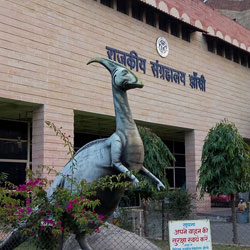
Jhansi, a battleground famous for the warrior queen Rani Jhani, is known to be a popular tourist destination among all the travelers that want to experience the rich past. And one such place where you can revive the complete experience of the history and the battles fought by Rani Lakshmi Bai is at the Government Museum, Jhansi. This is one of the most interesting places you can visit in Jhansi. Here, you can get a closer insight into the history of Jhansi and how our patriots and freedom fighters fought to get India the freedom that we enjoy so much now. What are the Traveler Tips when Visiting the Government Museum, Jhansi? If you are visiting the Government Museum of Jhansi, here are some things that you might want to know. The timing for visiting this museum is between 10 am to 5 pm. The entry fee for visiting this museum is just 5 Rs. For Indians and 25 Rs. For foreign tourists. Apart from that, you need to follow certain rules like no clicking pictures without permission, not touching the artifacts, and not making videos in the galleries where it is prohibited. What are the things you can do in the Museum? You can certainly go around and explore the many artifacts that are placed inside the museum. There are several art galleries that you can explore here. Whether you go to the art gallery of Guptas or the art gallery of Chandelas, everything is worth so much more. There are several weapons displayed inside the museum that was used in the Sepoy Mutiny of 1857. You can also see the terracotta and bronze structures of the historical time. What are the Timings and Availability? This museum is open for all tourists on all the days of the week except Monday and the second Saturday of each month. What is The History Of The Museum? The fight of Rani Lakshmi Bai against the Doctrine of Lapse passed by the British is still unforgettable. She was a true warrior who fought for the freedom of the people from the clasp of the British. At this museum, you can view the weapons that the warrior queen used while fighting. Apart from that, you can also see the illustrations of the battle that she so bravely fought. What Is The Best Time to Visit The Government Museum in Jhansi? Located in Jhansi, it is important that you pay special heed to the timing when you are visiting there. You need to be sure that Jhansi is a bit warm and can get pretty hot during the summer. You should avoid travels during hot weather if you want to enjoy the tour to the most. And the best time would be during the cool months. How to Reach? The government museum in Jhansi is located right in the heart of the city. You can come here when you are getting a trip to the famous Jhansi Fort. Located inside the Jhansi Kila, you can easily reach the Government Museum via road and rail. THE railway station and the bus station of Jhansi are at a very small distance. You can get a private cab or a taxi or an auto to reach here. If you are coming via bus, the Jhansi fort has a separate bus stop named after the fort right outside. You can get down here and walk a little to get to the museum. Nearest Places To Visit? The Jhansi fort is one of the biggest forts in Uttar Pradesh and is known to be standing majestically in its full glory. If you are planning a visit to the Government Museum, it is important that you spare some time to visit the fort as well. Apart from the fort, you can also explore the LakshmiBai park and Ishkon Jhansi which are very close to the Government Museum
Explore More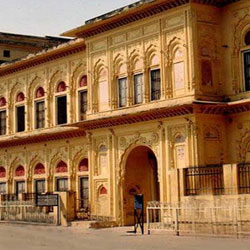
Rani Mahal, Jhansi is a royal palace and it was built by the Nawalkar family. This palace was habitant of Rani Laxmibai. Rani Mahal was built in the 18th century by Talwalkar family and after the death of Raja Gangadhar Rao, Rani Laxmibai used to live in the palace. It is two-storied building with one fountain on one side. It is situated in the Bundelkhand region and it lies on the banks of river Pahuj. Jhansi is also the entrance to Bundelkhand. Jhansi is around 415 km from New Delhi. Jhansi has various Rocky Mountains and also rich in minerals. The city has natural beauty with a marvelous connection with the various kings and most importantly with great warrior Rani Laxmibai. Once you think about Jhansi, it will remind all of us of the great battle of Rani Laxmibai with British soldiers. Jhansi is a city of palaces and also its architecture, sculptures and natural beauty. Traveler tips Jhansi is famous for Rani Laxmibai and her beautiful palaces and the Rocky Mountains. The best time to visit Jhansi is from November to March when it is a pleasant time. Jhansi does not have its airport but it is well connected with railways and roads. Things to do Jhansi is also famous for various arts and crafts, hence shopping is famous in Jhansi. There are lots of shopping markets available in Jhansi such as Sipri Bazar, Manik Chowk Bazar and many more. If you are visiting Jhansi then visit forts of Rani Laxmibai. This is an amazing place to visit and have experience in history. Availability The railway is well connected with Jhansi and various forms of transport facilities are available in Jhansi. There are numerous buses, Taxis, Autos, and trains that are available from Jhansi Junction and hence you can enjoy the beauty of great forts and rivers. History Jhansi was the capital of Marathas reign in the 18th century and it was also princely state for the period 1804 to 1853 till it became part of the British era. Rani Mahal situated in Jhansi is a tourist place in Uttar Pradesh and also it 103 km from Gwalior. Jhansi was also known by Balwant Nagar and later it was renamed to Jhansi. Architecture Rani Mahal was built by the Nawalkar family in the 18th century with beautiful architecture, sculptures, and paintings on the wall. Rani Mahal, Jhansi has now converted into a museum that has assembled various archaeological remains of that era. The beauty of ancient times will astonish and also keeps you amazed at such splendid beauty of wall paintings, sculptures, and many more things. Festival Jhansi is famous for Rani Laxmibai and her fort. However week-long Jhansi Mahotsav is celebrated splendidly in Jhansi and it is celebrated between February and March. You can have a marvelous experience of ceremonies and festivals when you come to Jhansi in festivals. Jhansi Mahotsav is organized by the Tourism board of Uttar Pradesh. Folk songs, Music, drama, and dances are part of such festivals. Visiting Jhansi will enrich your travel experience and also cherish you. Popular culture Jhansi is part of Bundelkhand and hence customs, culture, and traditions of Budelas prevail in Jhansi. Jhansi is determined by the culture of Mughals and Marathas and played an important role in its history. Badhai dance commonly executed at weddings and also on various occasions. Jhansi is influenced by various dynasties and also various kinds of dances are being performed in Jhansi. Best time to visit The best time to visit Rani Mahal, Jhansi would be October to March. Rani Mahal is open continuously during the year. However visiting Rani Mahal, Jhansi from October to March is best as the weather is pleasant during this period. How to reach? Jhansi is well connected with the major cities of Uttar Pradesh. Rani Mahal is about 2 km from the city of Jhansi. Jhansi is well connected with trains, buses, and airports. Taxis, autos, and buses are readily available to reach the Rani Mahal. The nearest airport is Gwalior, which is about 103 km from the Rani Mahal. Rani Mahal, Jhansi not only attracts domestic tourist but also tourists from other countries too. Interesting facts and trivia about Interesting facts about the Rani Mahal are that it is the place where Rani Laxmibai plotted a plan with great warrior Tanti Tope and also Nana Sahib to defeat the Britishers. It is also the fact that after Rani’s defeat British took over the charge of Palace and also killed Rani’s Bodyguard. Durbar Hall is a must-watch place that has royal magnificence. Nearby attractions There are lots of religious places, temples, palaces and many more nearby tourist attractions in Rani Mahal, Jhansi as: Jhansi Fort Jhansi Fort is situated at top of Bagira hill in the northern part of Uttar Pradesh. This fort was built in the 17th Century and it was later destroyed by the British. Jhansi Fort is open from 8 AM to 6 PM and the entry fees for Jhansi fort is Rs. 5 for Indians and Rs. 200 for foreign citizens. It is about 4 km from Jhansi Railway station. However, the transport facility is readily available to this fort. Barua Sagar Barua Sagar is about 24km from the Jhansi Railway station. Barua Sagar is also the abode of monuments, temples, and forts which reminds of history. Many popular temples are built on the banks of Barua Sagar. Parichha Dam Parichha Dam is about 27 km from Jhansi Railway station. Parichha Dam has constructed Pariccha town on Kanpur highway. Parichha Dam is built on Betwa River and it was constructed during the British era between 1881 to 1886. Parichha Dam is a thermal power station which produces 1149 MW power. Cenotaph of Raja Gangadhar Rao The monument is built in the memory of Raja Gangadhar Rao and it is situated about 2 km from Jhansi fort. The Cenotaph of Raja Gangadhar Rao is situated near Lakshmi Talab in Jhansi. It is one of the heritage sites in Jhansi and it is must visit Jhansi. The tomb has a beautiful scripture with gardens and flowers. Thus, pack your bag and move to Jhansi to visit these beautiful forts and palaces, monuments and many more places. To enjoy this place make a plan and visit this tourist place which is attracting lots of tourists from various places. Thus make sure that you will visit the Rani Mahal and also feel the history of great warrior Rani Laxmibai. There are lots of places for sightseeing which are nearby to Rani Mahal. Rani Mahal is a splendid example of beautiful architecture, paintings and remaining of the palace. Though forts are located in the hilly region and their beauty is lifetime watch. So just be ready and move to Jhansi and be a warrior of Jhansi and visit different places in and around it.
Explore More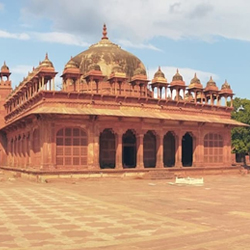
Ibadat Khana, Fatehpur Sikri is one of the most prominent places that visitors all around the world visit. Ibadat Khana is famous amongst the people majorly because of its high historical importance. If you know Mughal Emperor Akbar or have heard about it (who does not or who have not, respectively), you might also know that he is regarded as one of the great historians. Ibadat Khan is also known as the House of Worship. Ibadat Khana, Fatehpur Sikri was erected long back in the year 1575 AD with the motive to assemble spiritual leaders of different religions under one roof in order to share the respective religious teachings. Most of the discussions were made on Thursday evenings.History:As far as the history of Ibadat Khana, Fatehpur Sikri is talked about was built by Mughal Emperor Akbar. Akbar was an amazing believer of Salim Chisti who happens to be the best Sufi philosopher of that era. Amongst what all he did during his time, Akbar was known for his immense knowledge about almost everything as well as his magic which was believed to be next to impossible. In fact, he was a such a huge believer of Salim Chisti that he acknowledged the credit of all his victories to him. So much so, he also credited the birth of his son was also credited to the Sufi Saint. He was then inclined to dig more about Islamic religion as well as other ones.Then to fulfil his purpose, he went on to establish a place in 1575 which he termed as Ibadat Khana. It is at this place, the intellect and learned scholars would come along and hold discussions. Soon the place turned out to be one-stop place for discussions and arguments and also acquired immense popularity. People who used to gather here held the discussions and debates with all the enthusiasm. Akbar has always been a curious person and was attracted to different sorts of metaphysical kind of questions. And if you think that’s all, then you are miserably wrong for he also made his own religion by the name of Din-i-Ilahi, which was done in order to bring together the best of the practices of all the religions.Architecture:As far as the architecture of Ibadat Khana is talked about, it is made up of amazing red sandstone that is structured inside the Fatehpur Sikri. Whenever travellers visit Agra, Fatehpur Sikri is one of the must mentioned places right on that region. There is no denying the fact that Ibadat Khana has a unique and impressive architecture that makes it stand out of world. It is touted as one of the most spectacular places located inside the premises of the tourist hotspot. Ibadat Khana comprises of a single carved column standing in the middle, which also has a platform, which is believed to be the place where the emperor used to be seated. Right from there, we can see four paths that go into separate directions on the four corners of the place, which happens to be the advisors seat. This particular part of the Ibadat Khana has a significance attached to it which says that Akbar was open to all sorts of notions from all corners before zeroing down on any of the final decision.Having said that; there have been a number of controversies as well as discussions on the location of Ibadat Khana. Historians and scholars such as Percy Brown and VA Smith believed that there was a single pillar room inside Fatehpur Sikri. On the other hand, there are some historians like Saeed Ahmed Muraravi said that Ibadat Khana to was mound between Jodha Bai’s Mahal and the main mosque. Moreover, there have been a number of other buildings too that have been identified as Ibadat Khana. So much so that at one point, even Abdarkhana, Girls’ Madrasa, Lotus Pillar and the quadrangle that connects to Daulat Khana were also named as Ibadat Khana.Interesting Facts:For the ones who don’t know the origin of the Ibadat Khana went through a lot of controversy. The Ibadat Khana was constructed at a place where religious ideas could be discussed. It is also to be mentioned here that Ibadat Khana is fulsomely appreciated by the famous poet named, Lord Alfred Tennyson in his poem by the tittle, Akbar's Dream.Nearby Attractions:Fatehpur Sikri is one of the most famous tourist attractions in India and the ones who are travelling to this region can also explore other structures namely, Nubat Khana, Mariam-uz-Zamani, Ibadat Khana, Buland Darwaza, Jama Masjid, Panch Mahal, Jodha Bai's Palace, Tomb of Akbar the Great, Badshahi Darwaza, Taj Mahal and Birbal's Palace amongst many others.
Explore More
Mariam-Uz-Zamani Palace is the beautiful mausoleum that is dedicated to the Rajput Princess Jodha Bai who was married to the Mughal Emperor Akbar. The tomb or the palace was constructed by Mughal Emperor Jahangir in the memory of his mother Jodha Bai, who was also known by her other name Marium Uz-Zamani. The queen is also known by other names such as Hira Kunwari, Harka Bai, Heer Kunwari, etc. Situated within the main complex of Fatehpur Sikri, the Marium –Uz-Zamani palace is a stunning Mughal themed palace which is located in Sikandra-the outskirts of Agra, Uttar Pradesh. The structure is an architectural grandeur that manifests the elements of Mandu, Gwalior and the magnificent designs of traditional Islamic style. While visiting Fatehpur Sikri, one can visit this stunning palace. History Of Mariam-Uz-Zamani Palace: The first wife of Mughal Emperor Akbar, the Rajput queen, Rani Jodha Bai came to be named Marium –Uz-Zamani after she became the mother of Jahangir. The Rani was the longest-serving Hindu empress in the Mughal reign. The marriage of Jodha Bai and Akbar was one of the significant chapters in the history of India as it epitomized Emperor Akbar’s respect for other religions in India. The palace was located near Akbar's Tomb as per the last wish of Jodha Bai. The structure was originally a baradari (Pavillion) built during the reign of Sikander Lodi in AD 1495. It was later reconstructed into Mughal's tomb by Jahangir in Mughal style. Mariam-Uz-Zamani Palace was the seat of power during the reign of both Emperor Akbar and his son Jahangir. A lot of money was spent and the best architectures and workers were appointed to construct this magnificent palace. Architecture Of Mariam-Uz-Zamani Palace: This brilliantly built palace in Fatehpur Sikri is an excellent combination of size and aesthetics. The incredible carvings and impressive floral motifs catch the attention of visitors immediately. The interior and exterior of this palace adorned with floral and geometrical finishes and designs. Furthermore, the beautiful gardens surrounding the palace add a charm to the beauty & magnificence of the structure. As Mariam-Uz-Zamani (Jodha Bai) was a Hindu queen and used to worship Lord Krishna, the place is embellished with various paintings of Lord Krishna. One can see an impressive gateway in the eastern side of the palace, followed by various guard rooms having triangular ceilings. Visitors can see some of the Hindu motifs during their visit to this palace such as elephants, srivatsa mark, parrots, ghant mala, swans, etc. The building also comprises of Chhaparkhats with eight pillars, semicircular domes, and chhatris that attract the visitors the most. Interesting Facts About Mariam-Uz-Zamani Palace: • This palace is also known as Jodha Bai Palace. • One can see the Kitchen of Queen Jodha Bai inside the palace. • This palace was the biggest and most relevant part of the Imperial Harem. • It is said that Jodha Bai was an intelligent businesswoman, who was involved in performing international trade of spices and silk in Mariam-Uz-Zamani Palace. Best Time To Visit Mariam-Uz-Zamani Palace: Mariam-Uz-Zamani Palace in Fatehpur Sikri is one of the top attractions to visit near Agra. During the summer season, the entire region experiences extreme heat with a high temperature i.e. between 40 to 45 degrees Celsius. The heat can be annoying for many people, but if the heat does not bother you much, you can visit the palace during this period. During the winter season, the weather is pleasant and calm here, with an average temperature of about 15 degrees Celsius. So, this period is the best time for sightseeing and exploration in the region. How To Reach Here: Mariam-Uz-Zamani Palace is located at a distance of about 11 km from the Agra Cantonment Railway Station. By getting down at this station, visitors can hire taxis, cabs or auto-rickshaws to reach the palace. One can even get down at other railway stations in Agra such as Agra Fort Railway Station, Raja ki Mandi, Agra City, and Idgah Railway Station and reach the palace by taking private vehicles. One can also board daily buses ply between major cities of the nation to Agra and reach the Mariam-Uz-Zamani Palace by hiring private vehicles from the bus terminals. There are two bus terminals in Agra, from where one can hire taxis and cabs- Idgah Bus Stand and ISBT. Additional Information For Visitors: The Mariam-Uz-Zamani Palace remains open every day in a week from morning 6 am to evening 6 pm. Visitors need not pay any extra entry fee for visiting this palace as it lies within the Fatehpur Sikri complex. The entry fee required for Indian citizens and citizens of SAARC and BIMSTEC countries to enter the Fatehpur Sikri complex is Rs 35 and the entry fee required for international tourists is Rs 550. The entry fee for children who are under 15 years of age is nil. Nearby Attractions: While visiting the Mariam-Uz-Zamani Palace, visitors can explore some of the other places of interest in and around the region such as Tomb of Akbar the Great, Badshahi Darwaza, Taj Mahal, Birbal's Palace, Nubat Khana, Ibadat Khana, Buland Darwaza and many more.
Explore More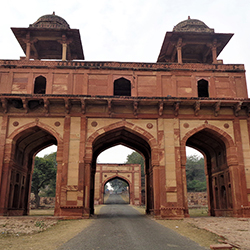
Situated at the entrance of the Fatehpur Sikri complex near Agra, Uttar Pradesh, Naubat Khana also known as Naqqar Khana is a Mughal era drum house that is famous for its stunning architecture and historical significance. Traveller tips: • Popular for: history, tourism, photography • Timing: 6:00am to 7:30pm • Visit duration: one hour • Entry fee: Since Nuabat Khana is a part of Fatehpur Sikri complex, you need to pay a fixed entree fee to visit the fort. • Indian nationals: Rs 40 • Foreigners: Rs 550 • Visitors are not allowed to carry food items, tobacco products inside the palace. • Avoid touching the walls and surfaces of the heritage monument • Wearing shoes is prohibited in the palace. • Photography is allowed in Fatehpur Sikri complex History and architecture: Naubat Khana, a significant part of Fatehpur Sikri palace, refers to a building where Naubat a kind of a special drum was played by musicians to announce the arrival of the emperor or during special occasions. If history is to be believed, musicians used to play Nuabat or drums at this building five times a day at appointed hours. Famous for its extravagant Mughal inspired architecture, Naubat Khana is an important structure of Fatehpur Sikri, a city erected by Mughal emperor Akbar. This beautiful three-storeyed, red stone made structure was used as a royal entrance during sultan Akbar’s reign. Featuring there elegantly designed archways, Naubat Khana is adorned with beautiful carvings and embellishments that depicts the excellence of Mughal architecture. Things to do Explore Naubat Khana, Fatehpur Sikri and other adhjusant monumnets to witness the supreme excellence of Mughal era-inspired architecture. If you are a history buff, opt for a guided tour to know more about its historical significance. If you have time, take a full day sightseeing tour to Agra to visit Taj Mahal. Best time to visit Located 36 km away from Agra, all the major attractions of Fatehpur Sikri can be covered during a day trip from Agra. With the temperature reaching a scorching height of 45 degree Celsius in summers (April-July), planning a trip to Naubat Khana is not recommended at this time. The best time to visit this place is between October and March as the weather during this time is pleasant. How to reach? Travellers can easily get local taxis outside the airport at nominal charges to reach Fatehpur Sikri. Naubat khana is a 5 minutes a walk from the main ticket counter at Fatehpur Sikri complex. By bus: Fatehpur Sikri is well connected through Uttar Pradesh State Road Transport Corporation (UPSRTC) buses and private coaches to neighbouring main cities like Agra, Delhi and many other. By train: Located nearly 40 km away from Fatehpur Sikri, Agra Cantt is the nearest railhead to Naubat Khana. Nearby attractions: Constructed in the traditional Mughal style of architecture, Naubat Khana, Fatehpur Sikri is a never miss out on a place on your full-day Agra sightseeing tour. Apart from Naubat Khana, there are many other nearby popular locations and monuments which you can consider for a full day sightseeing tour • Taj Mahal • Birbal’s palace • Buland Darwaza • Jama Masjid • Panch Mahal • Mariam-uz-Zamani • Ibadat Khana • Tomb of Akbar the Great Book a full day or half-day sightseeing tour to Fatehpur Sikri and Agra covering all the major historic monuments like Nuabat Khana, Taj Mahal, Ibadat Khana and many more.
Explore More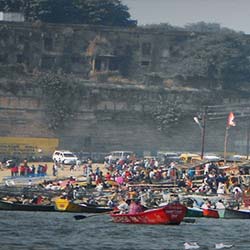
About The Allahabad Fort The Allahabad Fort, also known as the Prayagraj Fort, is a majestic fort located in the city of Prayagraj, Uttar Pradesh, India. It stands on the banks of the confluence of the Ganges and Yamuna rivers, making it a significant historical site in the country. Timings Of Allahabad Fort The Allahabad Fort is open for visitors from 8:00 AM to 5:00 PM on all days of the week. Entry Fee The entry fee for visiting the Allahabad Fort is INR 25 for Indian citizens and INR 300 for foreign nationals. Required Time And Restricted Items It is recommended to spend at least 2-3 hours exploring the fort and its surroundings. Visitors are not allowed to carry weapons, alcohol, or any harmful substances inside the fort premises. Architecture Of Allahabad Fort The Allahabad Fort showcases a perfect blend of Mughal and Hindu architecture styles. It features massive walls, intricately carved marble structures, underground rooms, and beautiful gardens that reflect the grandeur of its historical significance. Best Time To Visit The best time to visit the Allahabad Fort is during the winter months of October to March when the weather is pleasant and ideal for sightseeing. How To Reach The Allahabad Fort is easily accessible by road, rail, and air. The nearest airport is Bamrauli Airport, located around 12 kilometers away. Prayagraj Junction is the nearest railway station, and the fort is well-connected by road to major cities in the region. History Of Allahabad Fort The Allahabad Fort was built by Emperor Akbar in 1583 and has witnessed significant events in Indian history, including the famous Kumbh Mela and the Triveni Sangam. It has been a strategic military stronghold and served as a prison during the British colonial era. Inside Allahabad Fort Inside the Allahabad Fort, visitors can explore the iconic Ashoka Pillar, the Saraswati Koop, the Jodhabai Palace, the Khas Mahal, and the Zenana Palace. The fort offers breathtaking views of the rivers and the surrounding landscape. Traveling Tips It is advisable to wear comfortable footwear and clothing while exploring the fort, as there is a fair amount of walking involved. Carry water and snacks to stay hydrated and energized during your visit. Hotels Near Allahabad Fort Some of the hotels near the Allahabad Fort where you can stay are Hotel Kanha Shyam, Hotel Polo Max, Hotel Allahabad Regency, and Hotel Millennium Inn. Nearby Tourist Spots Of Allahabad Fort Some of the nearby tourist spots worth visiting are the Triveni Sangam, Anand Bhavan, Khusro Bagh, All Saints Cathedral, and the Allahabad Museum. These places offer a glimpse into the rich cultural and historical heritage of Prayagraj.
Explore More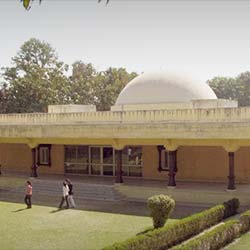
Jawahar Planetarium is a science museum and a planetarium named after the first Prime Minister of India, Pt. Jawaharlal Nehru. This planetarium is owned and managed by JLN Memorial Fund. It is a must-see attraction in Allahabad, especially for the ones that keep an interest in the celestial bodies. It is a frequented place of interest and is visited by various guests. It Is Known For:-1) Jawahar Planetarium lies beside Anand Bhavan, the former residence of the Nehru family. It is the right place for gaining the knowledge about the space and the solar system2) On all the celestial events like an eclipse or meteor shower, Jawahar Planetarium gets flooded with the people who wish to capture the sight of miracles happening in sky 3) The educational institutions also visit this planetarium in order to allow the children to gather more information about the planets and galaxies Best Time To Visit:-Jawahar Planetarium is a famous tourist attraction in the city. It is visited by the educational institutes as well as the guests on a vast scale. Though a casual visit is considered as appropriate, the best time for visiting Jawahar Planetarium is during the celestial activities like an eclipse, a meteor shower etc. Reaching There:Jawahar Planetarium lies next to Anand Bhavan. Since many people pay a flying visit to Anand Bhavan, they do not miss spending some time in the planetarium premises. A well-established network of the roadways and railways make it feasible for the visitors to reach the planetarium. The buses and taxis are available to reach Jawahar Planetarium conveniently. Nearest Railway Station- Allahabad JunctionNearest Airport- Allahabad Airport
Explore More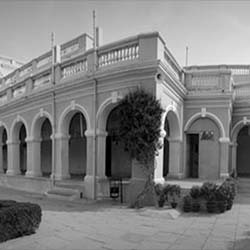
About The Swaraj Bhavan Swaraj Bhavan, located in Prayagraj, Uttar Pradesh, holds great historical significance as it was the ancestral home of the Nehru family. The beautiful mansion is now a museum and a popular tourist attraction that offers a glimpse into the lives of India's most influential political family. Timings Of Swaraj Bhavan Swaraj Bhavan is open to visitors from Tuesday to Sunday, between 9:30 AM to 4:30 PM. The museum remains closed on Mondays and public holidays. Entry Fee The entry fee for Swaraj Bhavan is INR 10 for Indian nationals and INR 250 for foreign tourists. There is an additional charge for the camera and video camera. Required Time And Restricted Items Visitors usually spend around 1 to 2 hours exploring the museum and its historic artifacts. It is important to note that carrying food, beverages, and large bags inside the premises is not allowed. Architecture Of Swaraj Bhavan Swaraj Bhavan is an architectural marvel, featuring colonial-style architecture with grand pillars and spacious courtyards. The interiors are adorned with vintage furniture, photographs, and memorabilia that showcase the rich heritage of the Nehru family. Best Time To Visit The best time to visit Swaraj Bhavan is during the winter months from October to March when the weather is pleasant and ideal for exploring the museum and its surroundings. How To Reach Swaraj Bhavan is easily accessible by road, rail, and air. The nearest airport is Allahabad Airport, located about 12 kilometers away. Prayagraj Junction is the nearest railway station, approximately 4 kilometers from the museum. Local buses and taxis are available for reaching Swaraj Bhavan. History Of Swaraj Bhavan Originally built in 1900 as the ancestral home of Motilal Nehru, Swaraj Bhavan later became the headquarters of the Congress party during the freedom struggle. It served as a pivotal venue for political meetings, discussions, and decisions that shaped India's independence movement. Inside Swaraj Bhavan Inside Swaraj Bhavan, visitors can explore the various rooms and galleries that showcase the life and times of the Nehru family. The museum displays personal belongings, letters, documents, and photographs that offer insights into the political legacy of the Nehrus. Traveling Tips It is advisable to wear comfortable footwear and clothing while visiting Swaraj Bhavan as there is a fair amount of walking involved. Additionally, carrying a bottle of water and sunscreen is recommended, especially during the summer months. Hotels Near Swaraj Bhavan Some of the hotels near Swaraj Bhavan include Hotel Kanha Shyam, Hotel Millennium Inn, and Hotel Milan Palace. These hotels offer comfortable accommodation options for tourists visiting the museum. Nearby Tourist Spots Of Swaraj Bhavan While exploring Swaraj Bhavan, visitors can also visit other nearby attractions such as Anand Bhawan, Allahabad Fort, Khusro Bagh, and Triveni Sangam. These places offer a deeper insight into the rich history and culture of Prayagraj.
Explore More